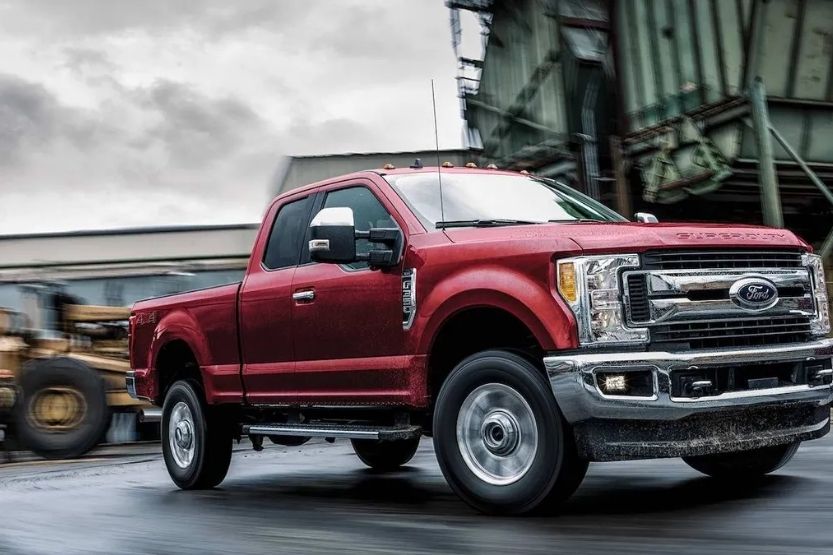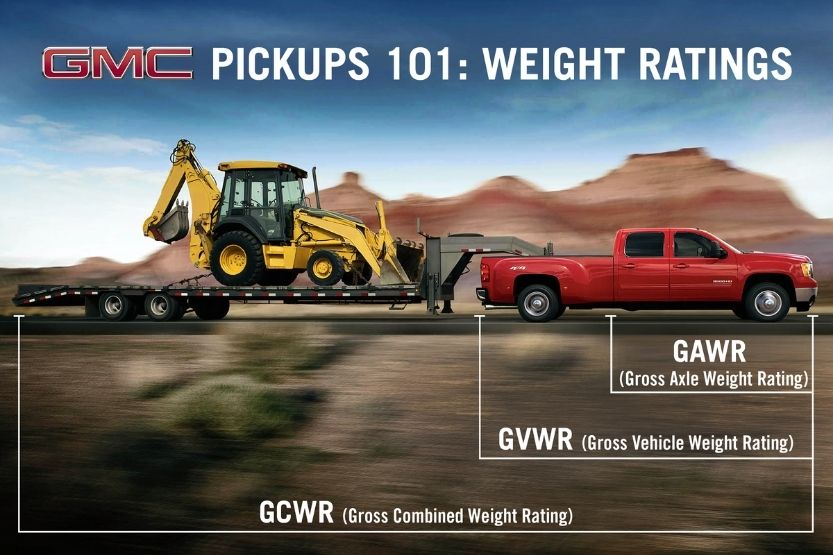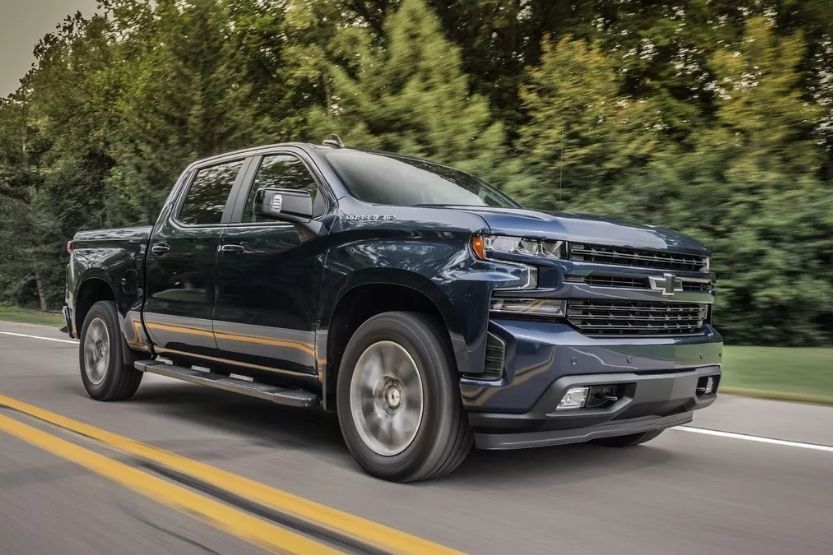When choosing a pickup truck to buy, it’s important to consider the weight. A heavier pickup truck can give better traction and momentum. A lighter pickup truck will be able to change direction and brake quickly. So, how much does a pickup truck weigh?
The average weight of a pickup truck ranges between 4,000 pounds and 4,700 pounds. But there are also pickup trucks that weigh over 4 tons, such as the GMC Sierra 3500 HD Crew Cab and the Ram 3500 Crew Cab. So, there are several pickup truck classifications, and they are all based on the weight of pickup trucks.
Read on to learn more about how much a pickup truck weighs, including the weight of different types of pickup trucks.
How Much Does a Pickup Truck Weigh? [Weight and Classification]

Commercial trucks operate by the GVWR and two classifications. The first classification is based on class, ranging from Class 1 to Class 8. The second classification is based on the size, consisting of Light, Medium, and Heavy. The United States Federal Highway Administration implemented this second classification.
Conventional pickup trucks feature a large and heavy-duty configuration or model. They typically go as high as Class 4. Anything higher than Class 4 is normally chassis cab trucks. Thus, they seemingly look like pickup trucks featuring a bare cargo bay. Nonetheless, they are two different types of vehicles.
Let’s take a look at various types of trucks according to class. These include the following:
- Class 1 – Light Truck
- Class 2a – Light Truck
- Class 2b – Light / Medium Truck
- Class 3 – Medium Truck
- Class 4 – Medium Truck
- Class 5 – Medium Truck
- Class 6 – Medium Truck
- Classes 7 and 8 – Heavy Trucks
1. Class 1 – Light Truck Weight
Light trucks under Class 1 have a weight limit ranging between 0 and 6,000 pounds. At the same time, the average weight of pickup trucks ranges between 4,000 and 4,700 pounds. To name a few, this type of pickup trucks include:
- Honda Ridgeline FWD
- Nissan Frontier
- Ford Ranger
- Toyota Tacoma
- GMC Canyon
- Chevrolet Colorado
- Jeep Gladiator
2. Class 2a – Light Truck Weight
Class 2a light trucks have a weight limit of 8,500 pounds, but they are still under the light truck category. They have an average curb weight ranging between 5,000 pounds and 5,500 pounds.
The pickup truck models under Class 2a include the following:
- Chevrolet Silverado
- GMC Sierra 1500
- Nissan Titan
- Toyota Tundra
- Ram 1500
- Lexus GX
- Honda Ridgeline AWD
- Ford F-150
3. Class 2b – Light / Medium Truck Weight
Under the Class 2b classification, trucks weigh somewhat between light pickup trucks and heavy-duty haulers. Their GVWR limit is 10,000 pounds. As for their average curb weight, it ranges between 6,300 pounds and 7,000 pounds.
The light or medium pickup truck models under this classification include the following:
- Ram 2500
- Nissan Titan XD
- Ford F-250
- Chevrolet Silverado
- GMC Sierra 2500
4. Class 3 – Medium Truck Weight
Pickup trucks under Class 3 have an impressive towing potential. They have a maximum weight limit of 14,000 pounds. As for the pickup truck weight, it ranges between 6,000 and 7,000 pounds. As a result, their GVWR limit is more than double their average curb weight.
Among the pickup trucks under Class 3 are the following:
- Isuzu NPR
- Ram 3500
- Ford F-450
- Ford F-350
- GMC Sierra 3500
- Chevrolet Silverado
5. Class 4 – Medium Truck Weight
Heavy-duty pickup trucks are under Class 4. Their maximum weight capacity is 16,000 pounds. At the same time, their average curb weight is ranging between 6,000 and 8,000 pounds.
However, heavy-duty pickup trucks differ in cargo bed configurations. This affects the total weight of each Class 4 vehicle.
Among the common medium pickup truck models under Class 4 are the following:
- Isuzu NPR-HD
- Ram 4500
- Ford F-450 Chassis Cab
- International CV
- Chevrolet Silverado 4500HD
6. Class 5 – Medium Truck Weight
The difference of Class 5 pickup trucks from Class 1 to 4 trucks is remarkably noticeable. Their chassis and cabins may be the same as several Class 4 pickup trucks. But the cargo bay significantly alters the layout of these trucks.
Class 4 and Class 5 pickup trucks may have similarities in terms of their appearance. But they have significantly different features. In other words, they are entirely different types of vehicles.
In most cases, Class 5 pickup trucks are used by farmers and repair companies. Their maximum weight capacity is 19,500 pounds. As for the curb weight, it largely varies. This is because these pickup trucks are focused more on carrying the load rather than towing.
Among the pickup trucks under Class 5 are the following:
- Ram 5500
- Ford F-550
- International CV
- Chevrolet Silverado 5500HD
7. Class 6 – Medium Truck Weight
Class 6 vehicles include chassis cab trucks, which have several variations. Some feature a bucket, a dump, or a flatbed. Some are straight trucks.
In most cases, conventional pickup trucks are not included in this classification anymore. Nonetheless, there are still several recognizable ones, including the following:
- Ford F-650
- International CV
- Chevrolet Silverado 6500HD
The maximum weight capacity of Class 6 vehicles is 26,000 pounds. Their average curb weight ranges between 8,000 and 9,000 pounds. But, again, it all depends on their configuration. There are instances when these vehicles can also easily reach a curb weight of 15,000 pounds.
8. Classes 7 and 8 – Heavy Truck Weight
You will hardly see pickup trucks under this classification. Class 7 and Class 8 trucks already include dump trucks and fuel tankers, among others.
The weight capacity of Class 7 trucks ranges between 26,001 and 33,000 pounds. Whereas the weight capacity of Class 8 trucks start from 33,001 pounds.
Is GCWR the Same as Towing Capacity?
What Is the Gross Vehicle Pickup Truck Weight Rating?

Gross vehicle weight refers to the total weight of a vehicle. This includes the fuel, cargo, passengers, and a percentage of the attached trailer’s weight.
The Gross Vehicle Weight Rating (GVWR) pertains to the vehicle’s total weight capacity limit. Vehicles must adhere to this to maintain safety.
Any truck exceeding its GVWR can result in its damage. It can affect its tires, transmission, and suspension, among others. Worse, it can result in accidents too.
Aside from that, exceeding the GVWR limit is considered a violation. If caught, the driver and/or truck owner will be subject to fines or even more serious charges.
Pickup Truck “Ton” Ratings
The first pickup trucks manufactured in the United States were only classified into three. The classification was based on their payload capacity. These included the following:
- Half-ton Trucks
- Three-quarter Ton Trucks
- One-ton Trucks
Payload capacities have increased through the years, but the same classifications are still being used. However, these classifications are now only being used to distinguish the sizes of the different truck models. It’s not about the payload capacity anymore.
Again, how much does a pickup truck weigh? An average-size pickup truck weighs about 4,000 pounds. But some pickup trucks weigh over 4 tons, such as the GMC Sierra 3500 HD Crew Cab and the Ram 3500 Crew Cab. There are several pickup truck classifications, and they are all based on the weight of pickup trucks.
Curb Weight of Pickup Trucks
When we say curb weight, it talks about the weight of the vehicle when empty. Therefore, it is important to know the curb weight of a vehicle. Without it, you can’t determine the maximum payload and towing capacity.
Why does curb weight matter? When you’re planning to haul something using your pickup truck, it’s important to remember this equation:
Payload Capacity = Gross Vehicle Weight – Curb Weight
Your pickup truck’s curb weight has an impact on its fuel economy. It also has an impact on how much it can tow and haul.
These are among the things that you need to know if you’re planning to buy a pickup truck.
Factors That Affect the Curb Weight
So, what makes one pickup truck heavier than the other? First, let’s talk about the different factors that affect the curb weight of pickup trucks. They include the following:
- Pickup Truck Model
- Cab and Bed Size
- 4 X 4 Trucks Vs 2 X 4 Trucks
- Engine Size
- Trim Level
1. Pickup Truck Model
Full-size pickup trucks differ in weight because they have heavy-duty versions. One example is the Chevrolet Silverado 3500HD. This model may seem to have the same features as the other trucks. But try to check all its features. For example, you would know that the Chevy Silverado 3500HD trucks are built to be sturdier and more durable than other pickup trucks.
2. Cab and Bed Size
The size of the bed and cab installed on a pickup truck impacts the curb weight. Not all beds and cabs measure the same.
An example of this is a pickup truck with a four-door super-crew cab style. It is apparently heavier than a truck with only two doors.
Suffice it to say that a pickup truck with an extra-long bed definitely has a heavier curb weight than a pickup truck with a short bed.
3. 4 X 4 Trucks Vs 2 X 4 Trucks
A 4 x 4 truck and a 2 x 4 truck may have a similar configuration, engine, and trim. But a 4 x 4 truck will always have a heavier curb weight than a 2 x 4 one.
One of the reasons for this is the transfer case. Also, 4 wheel drive trucks tend to have extra reinforcements. This is to ensure that they can run efficiently during off-road adventures.
2 x 4 pickup trucks lack those parts. This makes them have a lighter curb weight. But their towing and hauling capabilities are better than the 4 x 4 ones.
4. Engine Size
The engine undoubtedly has an impact on the curb weight. Eight cylinder engines are definitely heavier than the four-cylinder or six-cylinder ones.
Aside from that, there is a difference in weight too between diesel engines and gas engines. This is because diesel engines have to withstand the high compression and torque that diesel has. That’s why these engines are built sturdier and heavier. This means that diesel engines are heavier than their gas counterparts.
5. Trim Level
In most cases, the different trim levels don’t really have a remarkable impact on the curb weight. For instance, pickup trucks may have different types of leather seats. So the difference in weight is not as noticeable as the other items we have earlier mentioned.
However, there are also additional systems or heavier parts that form part of the trim. This higher trim level nonetheless affects the curb weight one way or another.
Curb Weight of Popular Pickup Trucks

Let’s look at the curb weight of some of the popular pickup trucks worldwide from 2018 to 2020. They include the following:
- Chevrolet Silverado 1500
- Dodge Ram 1500
- Ford F-150
- GMC Sierra 1500
1. Chevrolet Silverado 1500
The curb weight of the 2018 Chevy Silverado 1500 ranges between 4,515 and 5,461 pounds. Whereas the curb weight of the 2019 Chevy Silverado 1500 ranges between 4,257 and 5,155 pounds. As for the 2020 Silverado 1500, the curb weight is ranging from 4,520 to 5,240 pounds.
2. Dodge Ram 1500
2018 Dodge Ram 1500 pickup trucks have a curb weight ranging from 4,520 to 5,673 pounds. The 2019 Dodge Ram 1500’s curb weight ranges from 4,798 to 5,372 pounds. Whereas the 2020 Dodge Ram 1500 has the same curb weight as the 2019 model.
What Are the Differences Between the Ram 1500, 2500, and 3500?
3. Ford F-150
The 2018 and 2019 Ford F-150 pickup trucks have a curb weight ranging between 4,069 and 5,697 pounds. At the same time, the 2020 model has a curb weight ranging between 4,069 and 5,684 pounds.
4. GMC Sierra 1500
When it comes to the GMC Sierra 1500, the 2018 model has a curb weight ranging from 4,515 to 5,461 pounds. The curb weight of the 2019 model ranges between 4,257 and 5,155 pounds. At the same time, the 2020 model has a curb weight ranging from 4,520 to 5,240 pounds.
Conclusion – How Much Does a Pickup Truck Weigh?
On average, the weight of a pickup truck ranges between 4,000 pounds and 4,700 pounds. However, there are pickup trucks that weigh over 4 tons, such as the GMC Sierra 3500 HD Crew Cab and the Ram 3500 Crew Cab, among others. Therefore, several pickup truck classifications are all based on the weight of pickup trucks.
Just because pickup trucks look basically the same, it doesn’t mean that they weigh similarly, too. The heavier the pickup truck, the sturdier and more durable it is. Suffice it to say that their capability to tow and haul is different from one another too.
Related reading:


![How Much Does a Semi Truck Weigh? [With and Without Trailer] how much does a semi truck weigh](https://roadsumo.com/wp-content/uploads/2021/06/how-much-does-a-semi-truck-weigh-150x150.jpg)


![How Much Does a Ford F150 Weigh? [F150 Weight] f150 weight](https://roadsumo.com/wp-content/uploads/2021/07/f150-weight-150x150.jpg)
![How Much Does A Smart Car Weigh? [Smart Car Weight] how much does a smart car weigh](https://roadsumo.com/wp-content/uploads/2021/07/how-much-does-a-smart-car-weigh-150x150.jpg)
![Read more about the article Best Dash Cam [Top 12 Dash Cams for Car or Truck]](https://roadsumo.com/wp-content/uploads/2021/07/best-dash-cam-300x200.jpg)
![Read more about the article Types of Hyundai Cars [Full List – 16 Models]](https://roadsumo.com/wp-content/uploads/2020/10/types-of-hyundai-cars-300x200.jpg)
